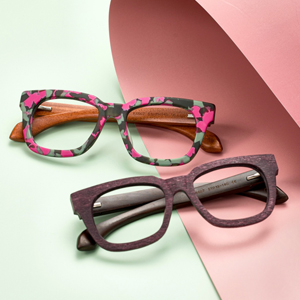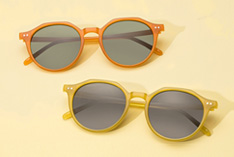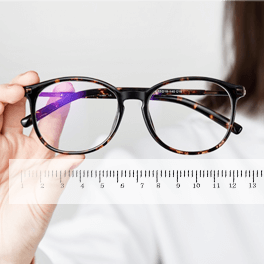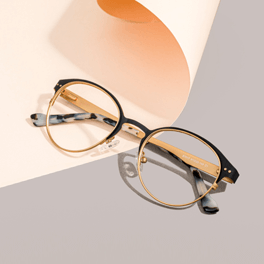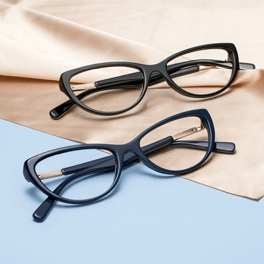FAQ
Quick Links
Frames
The parts of a frame are being called differently in the optical world. You can better understand eyeglasses and what your eye care provider talks about your glasses frames by knowing these names. Let's check this out!
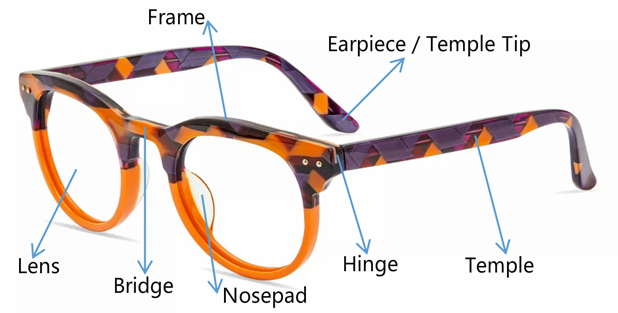
Glasses frames are measured in millimeters. The best place to pick up a new perfect fit is to start with the measurements printed on your current glasses. Once you get the detailed measurements, you can go with the style you like.
*Click to know how to select the frame style based on the face shape.
1. Read the Measurements Printed on the Frame and Measure the Frame
First of all, search for the three little numbers stamped on the inside of the temple of your glasses. It's usually printed as "XX XX XXX" or "XX-XX-XXX".
The measurements in picture "49☐24 140" are lens width, bridge width, and temple length. Frame size also refers to other detailed measurements like lens height and frame width.
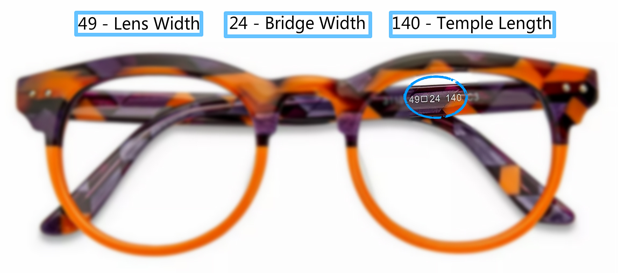
Getting the following accurate measurements of your current glasses can better help you locate the perfect fit from our hundreds of stylish frames. Keep in mind that all these are in millimeters.
1. Lens Width 49-24-140
It is the horizontal width of each lens at its widest point. It typically ranges from 40 to 60 mm.
This measurement plus lens height determines whether the lenses look big or small on your face.
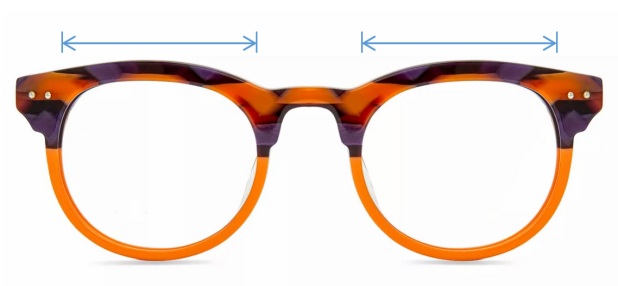
2. Bridge Width 49-24-140
It is the distance between your two lenses which is the space where your frames fit against your nose. The size of this piece ranges from 14 to 24 mm.
This measurement plus temple length indicates if the glasses will sit stably and comfortably on your face.
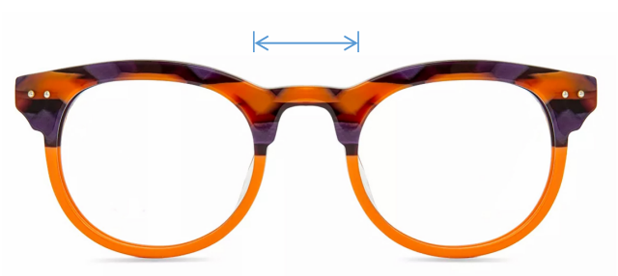
3. Temple Length 49-24-140
It is the distance from each screw to its temple tip, including the bend that sits on your ear. The temple is typically 120 to 150 mm long.
Temple length and bridge width indicate if the glasses will sit stably and comfortably.
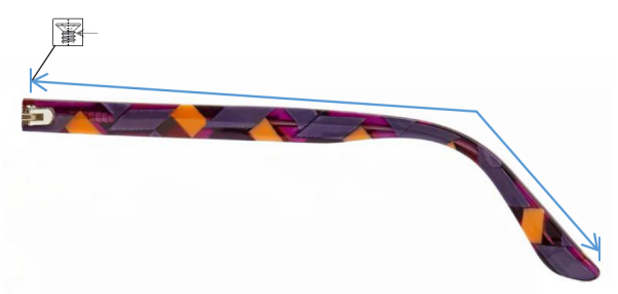
4. Lens Height (measure it yourself)
It is the vertical height of each lens at the highest point of the lens within the frame. It is vital for bifocals and progressives production.
This and lens width determines whether the lenses look big or small on your face.

5. Frame Width (measure it yourself)
It is the horizontal width across the front of the frame from one screw to the other. It is necessary to find out if the frame is wider or narrower than your face.
No more than one finger width between the temple and your face is better.
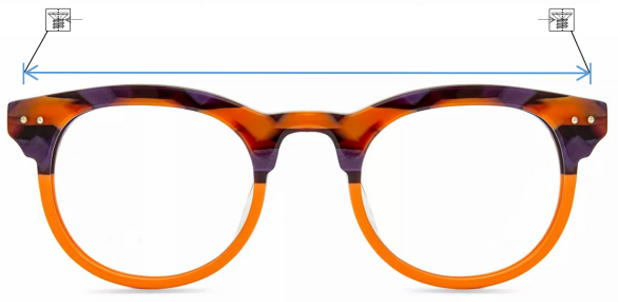
Frame Width Standard Chart
Zinff has four frame width standards (XS, S, M, L). You may need to pay attention to the lens size (lens width and height) and temple length to make sure your new glasses correctly fit your face.

2. Search the Perfect Fit due to the Measurements You Got
A perfect pair of eyeglasses are always sitting stably and comfortably on your face to give you clear vision. Your eyes should be directly in the center of the lens, from left to right, and fill the top half of the lens. The bottom of the eye should roughly touch the vertical midpoint of the lens.
Opticians usually suggest that you keep the lens size within 2 mm of your current frame (unless you are intentionally choosing an over-sized style), within 2 mm of your current bridge size, and within 5 millimeters of your current frame's temple length.

Step 1: Find the Perfect Frame Width
A glasses frame that is too narrow will make your face look wider, while a wide glasses frame will make your face look too narrow. Your perfect fit should be slightly wider than your face - no more than a finger's breadth (3/4 of an inch or 19 mm) between the temple and your face.
If your current frame doesn't fit, stick with the "one finger-breadth" rule when selecting frames. If your glasses are a little wider or narrower, you can slightly bend the temples outward.
*Click here to find out more information about adjusting the frame to fit.
Step 2: Get Cozy with the Temple Arm
The temple should fit horizontally and evenly along your face and fit comfortably along the outside of your ear.
If you select a frame with longer temples than your current ones, you may have a problem with glasses sliding down your nose. However, you can still have the temples bent to keep them in place.
*Click here to find out how to adjust the frame to fit.
Step 3: Pick the Right Lens Height and Width
Lens height and width indicate the size of lenses. Your eyes should be directly in the center of the lens, from left to right, and fill the top half of the lens. The bottom of the eye should roughly touch the vertical midpoint of the lens.
If the lens size is too big, it may cause you vision issues (blurry vision, headache) with the glasses. The bottom frame rim may touch your cheeks as well. The most important is that the lens would be thicker than the smaller frame, especially with a strong prescription.
Step 4: Select the Ideal Bridge Width
The bridge of your glasses should sit stably and comfortably against your nose. If your PD measurement is small, the ideal bridge width is a lower number. Otherwise, a higher number is better.
*Click to find out what PD is and how to measure it.
You can calculate the frame PD comparing to your PD to check if the frame will sit properly on your face: Frame PD = Lens Width+Bridge Width.
You can identify your face shape by measuring your face. Four measurements of your face are necessary.
Step 1: Get four measurements first
√ Forehead Width: Measure your forehead at the widest point (from left hairline to another).
√ Cheekbone Width: Measure the distance across your face to the same spot on the other side (from your hairline above your cheekbone).
√ Jawline Width: Measure your jawline at the widest point (about 1 inch down from your ears).
√ Face Length: Measure your face length (from the middle of your hairline to chin).
Step 2: Compare the measurements to identify the face shape
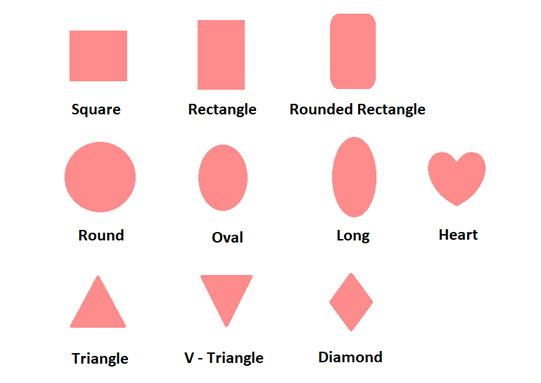
When your forehead width is similar to cheekbone width and face length.
1.Pointed Jawline: Oval face shape
2.Boxy Jawline: Square face shape
3.Rounded Jawline: Round face shape
When your forehead is slightly wider than your cheekbone, and its width is shorter than its length.
1.Pointed Jawline: V-Triangle face shape
2.Soft Curved Jawline: Heart face shape
3.Boxy Jawline: Rectangle face shape
4.Rounded Boxy Jawline: Rounded Rectangle face shape
5.Rounded Jawline: Oval/Long face shape
When your forehead is narrower than your cheekbone, and its width is shorter than its length.
1.Pointed Jawline: Diamond face shape
2.Boxy Jawline: Triangle face shape
3.Rounded Jawline: Oval/Long face shape
Face Shape & Frame Shape/Style
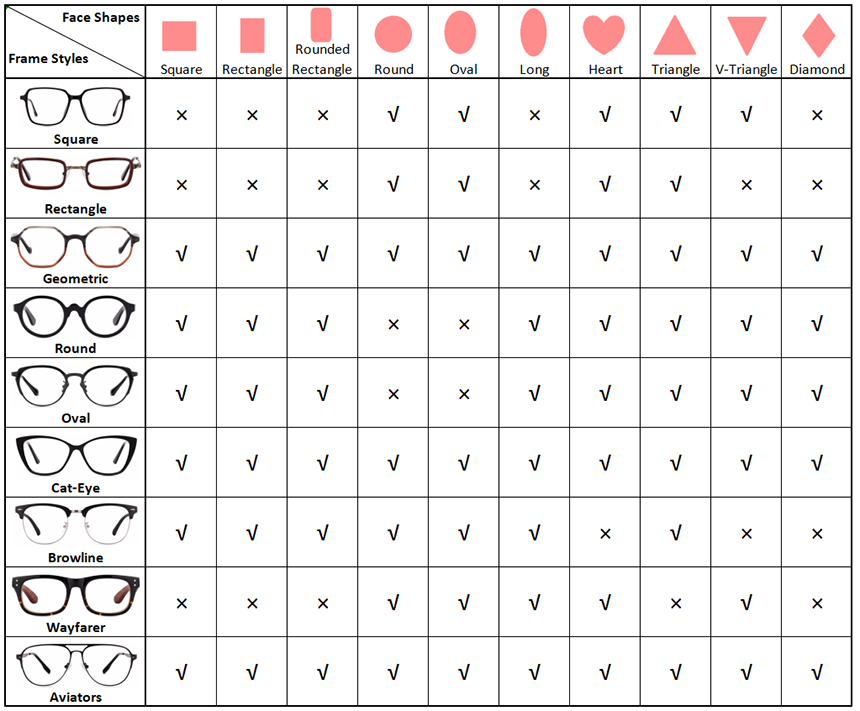
The frame choices affect how thick your lens is referring to your prescription. Good frame choices can make your lenses more fashionable and functional, especially for those who have high prescriptions.
A change of frame's shape and size, lens index, and material can make you feel your prescription off sometimes. Changing to wrap-around frames can alter the curve of the lens and take you longer to adjust to these frames.
Lens thickness relates to frame shape and size, lens choice, and your prescription. If your current glasses are fit, we recommend you stick to a similar frame shape and size. But it doesn't mean that you cannot select an over-sized frame. You can still get your new style with a higher index of lens choice.
Lens thickness refers to your prescription, frame choices, and lens choices.
*Click here to check how to pick out the best lens due to prescription.
We all know that there are several numbers on the prescription if you have one. The numbers are appearing with a negative or positive sigh. The negative numbers and positive numbers on the sphere section determine what type of eyesight issue you have.
Negative sphere numbers indicate that you are near-sighted (can see well up-close but have trouble focusing into the distance). Positive numbers are for far-sighted (can see well into the distance but need help focusing up-close).
The higher the prescription, the thicker the overall lens. If you have a strong prescription, you need to select the most suitable lens to make your lens as thinner as possible.
Click here to check how to pick out the lens index due to prescription.
For Near-Sighted
The lens for near-sighted will be thinner at the center and thicker at the edges. For frame choice, looking for frames that don't draw attention to the rims is necessary. Otherwise, your lens may look thick or clunky.
In an oversized frame, it can create the classic "coke bottle effect" where a thick lens peeks out of the sides of the glasses. However, this can be solved simply by choosing a shorter, narrower, thicker plastic full-frame or hi-index lens (1.74 index).

For Far-Sighted
The lens for far-sighted will be thicker at the center and thinner at the edges which can result in a "bug-eyed effect" where your eyes are magnified and the sides of the face look diminished.
This can be solved by choosing a shorter, narrower, thicker plastic full-frame or hi-index lens (1.74 index).

Multifocal glasses are used to see far, near, and in between all in one pair of glasses. Frame choices are important for multifocal glasses to get the best vision.
√ Select the frame size similar to your current ones.
√ Shorter frames with round edges are ideal (horn-rimmed, retro wingtip, circular, and oval frames).
√ Avoid Aviator and Cat-Eye frame styles (the bottom portion of reading vision may be cut off).
√ Adjustable rubber nose pads can help your glasses stay in place.
√ Glasses with spring hinges increase durability.
√ The lens height is at least 28 mm for the fitting height (segment height).
√ Check the weight of the glasses, the lighter the better.
Frame Shape References:

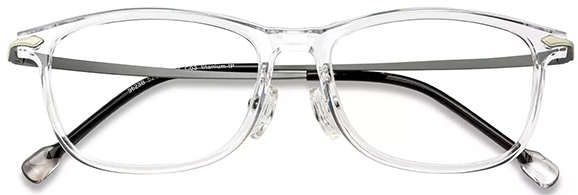
While you go to the frame page, you will find a "SPECIFICATIONS" section for frame details showing if the frame is good for bifocals or progressives.

At Zinff, we offer you hundreds of chic glasses, and high-quality lenses and we bring in new styles regularly.
We offer full rim, semi-rimless and rimless frames made of different materials to fit every daily style or party look. To pick a perfect pair, here are some tips for you.
*Click here for how to measure your frame.
*Click here to find out how to be chic with eyeglasses!
Frame Styles:
Full-Rimmed Frames
If a bold style is what you're looking for, full-rimmed eyeglass frames may be your best option. These frames fully enclose your lenses with the material, offering a sturdy-yet-stylish pair of glasses. Available in all frame materials — from acetate and plastic to metal and titanium — our full-rim eyeglasses always make a statement and come in an endless variety of styles, colors, and sizes.
Semi-Rimless Frames
If you’re looking for the best of both worlds, semi-rimless eyeglass frames may be the best choice for you. These hybrid frames bring together the minimalism of rimless frames with the full-rim durability. More lightweight than full-rimmed styles, but bolder than rimless eyeglasses, semi-rimless styles are classics with plenty of personality.
Rimless Frames
Rimless eyeglass frames are the best choices for those who favor a minimal look and feel. Lightweight and modern, rimless glasses offer plenty of style without taking over your face. With the only elements being the temple arms, the nose bridge, and hinges, these frames keep a low profile on your face without the extravagant design elements of full-rim glasses. They also come in various metals, including titanium.
Frame Materials:
Metal is a popular material for eyeglass frames, particularly for rimless and semi-rimless frame styles. Many people opt for metal frames because they are attractive and for their malleability and resistance to corrosion. Metal frames are a classic standard and are suitable for just about any lifestyle, from the creative to the office worker. They’re also great choices for people of all ages and genders.
Titaniumframes are very popular because they are lightweight, durable, strong, and corrosion-resistant. Titanium frames can be made in a range of different styles, from modern to classic. They are also hypoallergenic, and they retain their shape better than other metals as they flex when a force is applied. Strong, lightweight, corrosion-resistant, and hypoallergenic properties make our titanium eyeglasses ideal for fashion-conscious, high-performance lifestyles.
Plastic
TR is referred to as plastic titanium. TR frames are lightweight and resistant to impacts and high temperatures. It comes in a range of colors and won't release any chemical residues. However, it is a little less durable than metal and may fade, and lose strength over time. Plastic is one of the most durable-yet-economical materials available for eyeglass frames. Lightweight and comfortable, they're ideal for people who want bold frames without the weight.
Acetate is a nylon-based plastic, which means it's very strong and lightweight. Acetate comes in many different colors, with a high, rich luster, and is produced in high-quality, sandwiched sheets. The frame is stamped out from these sheets and requires handcrafting to attain its final shape and appearance. With their wide range of colors and glossy finish, acetate frames combine hard-wearing durability with stylish good looks.
Stainless Steel frames are lightweight, high-strength, and hypoallergenic. It is hard to make eyeglass frames with stainless steel due to welding difficulties; however, stainless steel temples are extremely springy.
Ultem is a polyetherimide resin. Ultem glasses are strong, stiff and resistant to a broad range of chemicals. Their lightweight and flexibility makes them very comfortable to wear.
Co-biodegradable Material
BioAcetate is an eco-friendly and high-performing alternative material that is non-toxic and free from harmful phthalates. BioAcetate uses renewable resources and is biodegradable and recyclable. This material is ideal for injection molding applications and handmade acetate frame production that is well-suited for high-end optic and eyewear frames.
Yes. Just choose "Non-Prescription" in the "GLASSES TYPE" section when selecting all the free lens choices.
Please note that we will still offer lenses with your frame in case the frame deformed in transit. You can remove the lenses yourself after you receive your glasses.
*Click here to find out how to pop out the lenses.
Yes. At Zinff, we offer visual frame references. It is "TRY ON". You can find it on the frame page. This tool is only for style references. If you want to pick out a fit pair, you need to find out your frame size first.
*Click here to find out how to use the "TRY ON" tool.
"Try On" is a functional tool to get visual references with your face. You can find it on the frame page you selected. The "Try On" is on the right side of the site under the "Select Lenses" button.
You need to upload your picture, locate your pupils, and enter your PD. Click here for how to get your PD.
Please note that "Try On" is only for style references. To get a perfect pair, you need the detailed measurements of your frame as well.
*Click here for how to measure your frame.
"Try On" is used for style visual references. If you want to pick up a perfect pair, you also need the detailed measurements of your frame.
Click here for how to measure your frame.
If the frame you like is out of stock, just contact us with the frame's name and color. We'll check with our manufacturer when it will be back in stock and get back to you as soon as possible.
We don't have a specific section for kids' glasses now, but we have lots of eyeglasses in "S" size.
Lens width for a child is likely between 40 and 50 mm. The bridge width is similar to that of an adult. And the temple length is generally shorter.
If your kid already has a pair of glasses, then choose a similar size.
Click here for how to measure your frame.
Glasses should sit comfortably on the bridge of your nose and shouldn't press against your eyebrows or cheeks. Taking glasses to an optical store to get them adjusted will cost you more time and money. Self-adjusting your glasses is a valuable skill appropriately.
Frames have different adjustment methods due to their material. You need to know the material characteristics before you start to adjust them.
For Plastic Frames
Plastic frames are not very pliable at room temperature. Due to their elastic nature, adjusting plastic frames can be more difficult than metal frames. They're likewise more difficult to deform than metal frames. You can warm up the frames before adjusting them. But you should avoid running warm water over your lenses.
Basic steps:
Step 1: Run the temple arms under warm water (90℉-110℉/32℃-43℃) for at least 30 seconds.
Step 2: Apply LIGHT pressure to the area where you need to adjust.
Step 3: Try your glasses on after each adjustment before making more adjustments.
Step 4: Place your glasses on the table to check if they sit stably and if the temple arms are adjusted consistently.
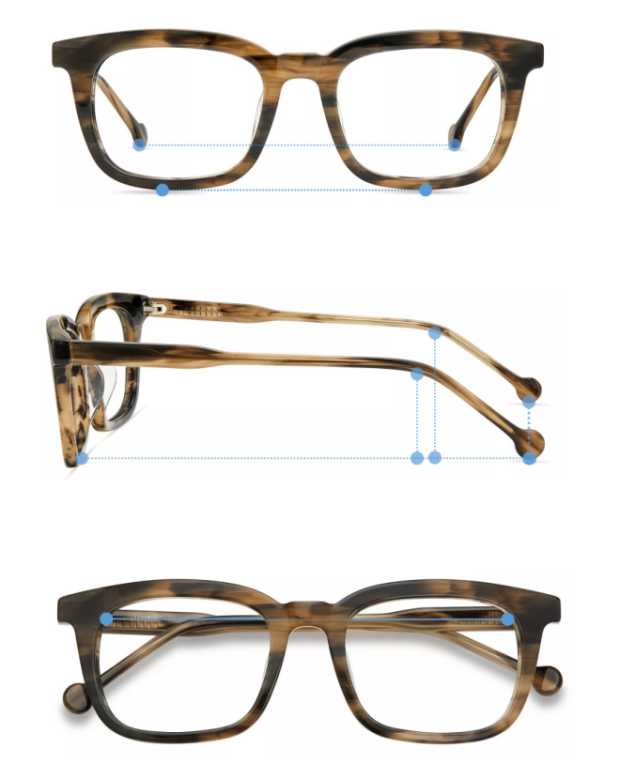
Helpful tips:
◊ Warm water is around 90℉(32℃) and not above 110℉(43℃). DO NOT use boiling water.
◊ Avoid running warm water over the lenses, as it can affect the lens coatings.
◊ Adjust frames a little at a time to avoid overcompensating.
◊ Make sure to try your glasses on after each adjustment.
For Metal Frames
Metal frames do not require heat to adjust them but may require frequent adjustments since some metals used to manufacture eyeglasses are easily bent through daily activity.
Basic steps:
Step 1: Apply LIGHT pressure to the area where needed until a noticeable change is made.
Step 2: Try your glasses on after each adjustment before making more adjustments.
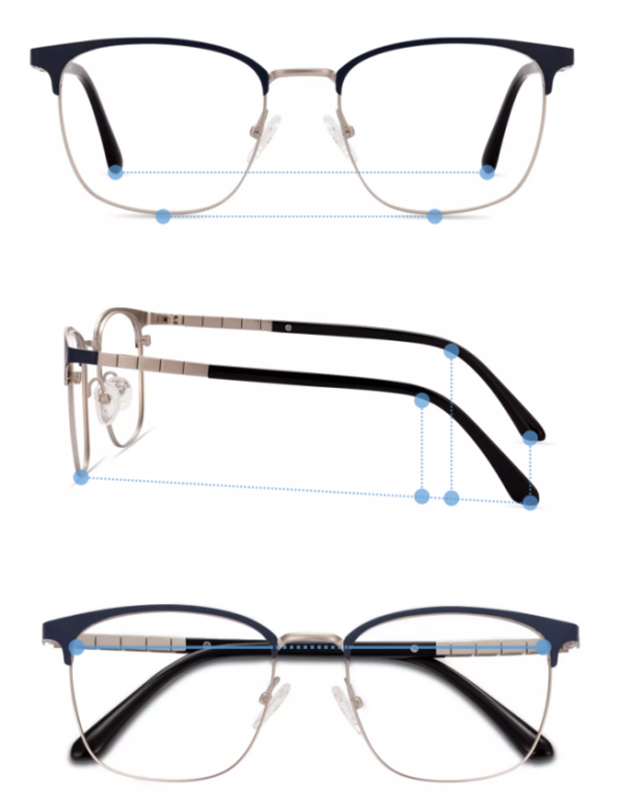
Helpful tips:
◊ Adjust frames a little at a time to avoid overcompensating.
◊ Make sure to try your glasses on after each adjustment.
HOW TO ADJUST THE FRAMES IF
1. Pinching Your Nose/Ears/Head
FOR PLASTIC FRAMES:
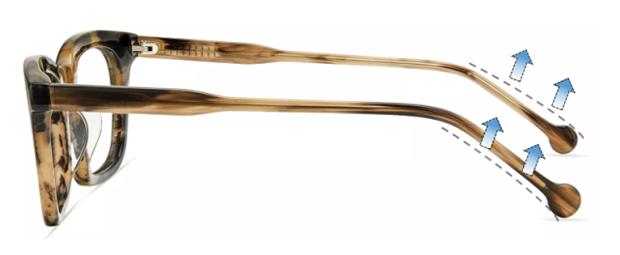
Grip each temple arm and slightly bend upward and outward at where it crosses over your ear to achieve a relaxed fit behind your ears.
The angle of each temple arm should be the same.
FOR METAL FRAMES: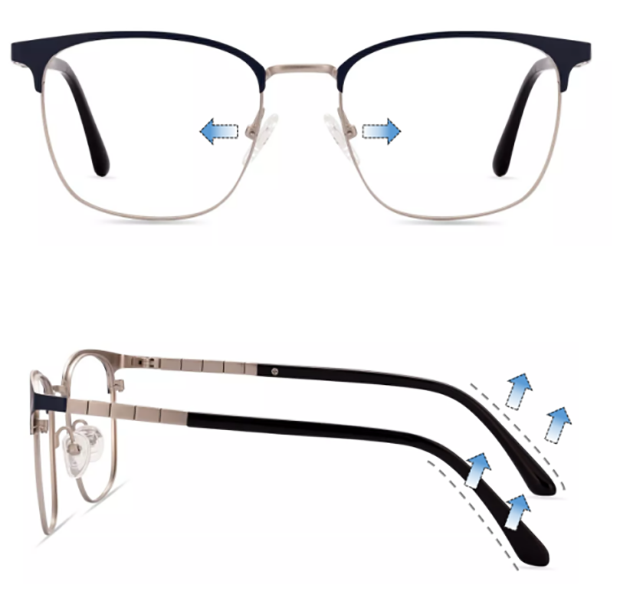
Push the nose pads outward until they fit comfortably.
The angle of each nose pad should be the same.
Grip each temple arm and slightly bend upward and outward at where it crosses over your ear to achieve a relaxed fit behind your ears.
The angle of each temple arm should be the same.
2. Slipping Down Your Face
FOR PLASTIC FRAMES:
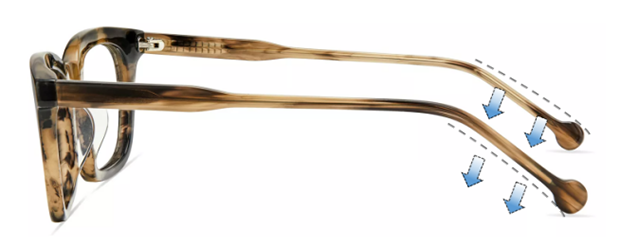
Grip each temple arm and slightly bend downward and inward at where it crosses over your ear to achieve a tighter fit behind your ears.
The angle of each temple arm should be the same.
FOR METAL FRAMES:

Push the nose pads inward until they fit comfortably.
The angle of each nose pad should be the same.
Grip each temple arm and slightly bend downward and inward at where it crosses over your ear to achieve a tighter fit behind your ears.
The angle of each temple arm should be the same.
3. One Lens is Higher Than the Other
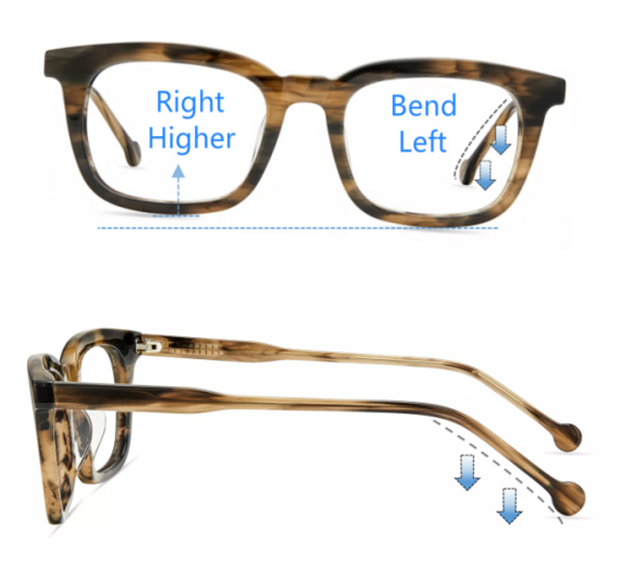
Bend the opposite temple arm slightly at where it crosses over your ear downward to keep the height of the two lenses consistent.
The angle of each temple arm should be the same.
4. One Lens is Closer to Your Eye Than the Other

Bend that lens's arm slightly at where it crosses over your ear inward and the opposite arm outward to keep the distance consistent.
The angle of each temple arm should be the same.
Zinff offers hundreds of stylish frames and brings in new styles every day.
If you wear glasses for daily use, working your style with glasses is essential.
For Frame Style
To pick out the frame suitable for your face, you have to identify your face shape first. For example, an oval face shape almost fits every frame style.
Click here to find out what face shape you are.
For Frame Size
The frame should not look too big or too small on your face. The top of the frame should follow the line of your eyebrows and avoid having too much eyebrow above or below the glasses frame. Your eyes should be in the center of the lens and fill the top half of the lens.
Click here to find out how to pick out your perfect fit.
For Frame & Lens Colors
When selecting the color of the frame and the lens color of sunglasses, you should look for the one that compliments your natural coloring (your skin, hair, and the colors you wear most often).
You can also take the seasonal fashion color as a reference. And it's better to have your clothes' color to match your glasses.
*Click here to pick out our floral & pattern frames.
Makeup Tips to Lighten Your Glasses
√ Curl your lashes to make the most of your gorgeous eyes.
√ Use a good under-eye concealer to avoid dark circles looking worse.
√ Put setting powder on the areas where your glasses touch your skin to prevent your foundation from rubbing off.
Wear bold or brightly colored eyeliner and eyeshadow if your glasses are thick and dark.
*Click here to pick out your holiday fashion for frames.
*Click here to check out your occasion styles for frames.
You need to stick with the method of measuring the detailed size of your glasses first when selecting a new frame.
*Click here for how to measure your frame.
If you can't see clearly with your glasses or the glasses don't sit stably and comfortably on your face, you may need some adjustments for your frame. Additionally, adding a little difference in size when buying a new one is necessary.
*Click to check out more about how to adjust the glasses frame.
When you want to get your old glasses frame replaced, you need to pop out the lenses and put them into the new frame. Or you want to wear the glasses without lens for fashion. Please note that the lenses cannot be removed yourself if you have a semi-rimless frame.
Use an eyeglasses screwdriver and follow the steps below, you can easily remove the lenses. Don't forget to wash your hands with a cleaning solution first.
For Plastic Frame
Step 1: Double-check if there are any small screws on the back of the lenses and the frame sides holding the lenses in place. The lens screws are not the same as the ones that hold the arms on. Not all plastic frames have screws.
Step 2: Remove the lens screws, if present, using the eyeglass screwdriver to turn the screws counterclockwise. It may take a bit of effort, especially if this is your first time to remove the screws. Set the screws aside in a safe place.
Step 3: If your room temperature is very low, you may need to warm your glasses frame up a little bit first. Run the front of your glasses frame under warm water (90-100℉/30-37℃). Do not use hot water because overheating will get your lens and frame damaged.
Step 4: Dry your glasses with Zinff microfiber cloth and wrap the lens with it when removing the lenses. Let's start popping out the lenses one by one!
Grasp the left side of the frame in your left hand with the lenses facing downward. Put your left thumb against the right side of the bridge (in case you break the frame from the bridge).
Hold the right side of the frame in your right hand with your right thumb against the top center of the back of the lenses. Push firmly to pop the right lens out with your right thumb. Do not force the lens out.
After removing the right lens, put your hands and thumbs in the opposite positions to remove the left lens.
For Metal Frame
Step 1: Locate the small screws holding the lenses. The location of the screws depends on the style of your frame. First, check on the inside of your frame to see if there are two screws on the nose bridge. If not, look on the sides of your frames underneath the arm hinges for the screw. If you still can't find screws there, check along the bottom rim around your lenses to see if the screws are hidden there.
Step 2: Remove the lens screws, if present, using the eyeglass screwdriver to turn the screws counterclockwise. This may take a bit of effort, especially if this is the first time the screws have been removed. Set the screws aside in a safe place.
Step 3: Wrap the lenses with Zinff microfiber cloth, so you don't get fingerprints on them. Remove the lenses one by one.
Grasp the left side of the frame in your left hand with the lenses facing downward. Put your left thumb against the right side of the bridge (in case you break the frame from the bridge).
Hold the right side of the frame in your right hand with your right thumb in the top center of the back of the lenses. Push firmly to pop the right lens out with your right thumb. Do not force the lens out.
After removing the right lens, put your hands and thumbs in the opposite positions to remove the left lens.

